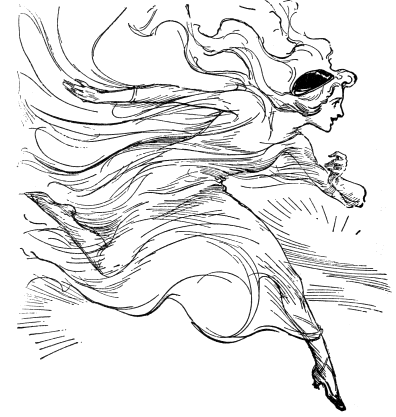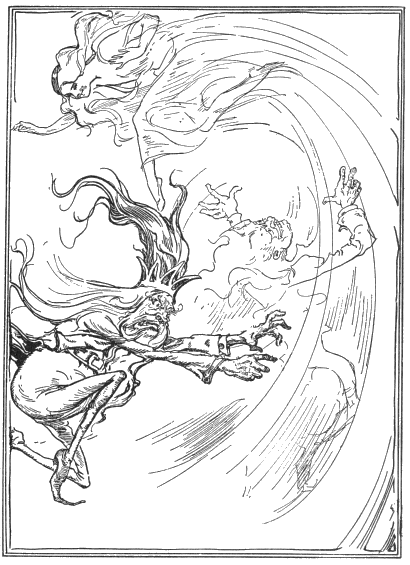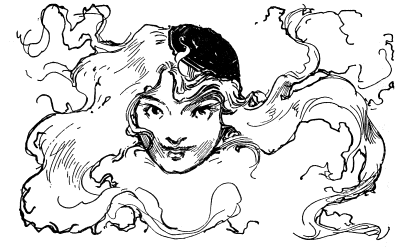Polychrome and the Nome King, or, I Perceive You Are a Fairy
From CHAPTER 17 of TIK-TOK OF OZ by L. Frank Baum.
For those of you unfamiliar with Polychrome, she of one of my two favorite fairy girls to appear in the pages of the Oz books of L Frank Baum, the other being Queen Anne Soforth. Allow me to introduce you to both, dear reader.
Queen Anne Soforth of the land of Oogaboo, who is described as “old enough to make jelly”, rules over the smallest and poorest kingdom in one corner of the Land of Oz.
Deciding one day she no longer wishes to do housework, she gathers her army, consisting of sixteen officers and one private soldier (which, as it happens, is all the men in her kingdom save one), and sets out to conquer the Land of Oz.
Afterward she planned to go out into the world and conquer other lands, and then perhaps she could find a way to the moon, and conquer that. The text explains: “She had a warlike spirit that preferred trouble to idleness.”
In my opinion, the effort is less absurd than the author seems to think, since her soldier is immortal and invulnerable: for the people of Oz are under the blessing of the first fairy queen, and cannot age nor die. Asura from Hindu Myths have conquered worlds armed with blessing no less potent.
Queen Anne soon encounters Polychrome, the rainbow’s daughter, once again accidently stranded on Earth when she ventured too far from the foot of the rainbow after a shadow; and the Shaggy Man, a wandering bum beloved of everyone, for he owns the Love Magnet; and the copper clockwork man, Tik-Tok, literature’s first depiction of a robot.
Betsy Bobbin and her talking Mule comprise the balance of the party. Through misadventure and untoward pride, they companions soon find themselves prisoners of the underground Nome King, who is offended that surface dwellers mine his metals out of his ground, instead of being content with the surface, which is their own. He is, of course, a temperamental tyrant, cruel to his underlings, and a powerful sorcerer with a magic belt of jewels.
We join the scene as Polychrome makes her appearance in the vast bejeweled cavern throneroom of the monarch.
*** *** ***

The Nome King, thinking himself wholly master of the situation, was laughing and jeering at his prisoners when Polychrome, exquisitely beautiful and dancing like a ray of light, entered the cavern.
“Oho!” cried the King; “a Rainbow under ground, eh?” and then he stared hard at Polychrome, and still harder, and then he sat up and pulled the wrinkles out of his robe and arranged his whiskers. “On my word,” said he, “you are a very captivating creature; moreover, I perceive you are a fairy.”
“I am Polychrome, the Rainbow’s Daughter,” she said proudly.

“Well,” replied Ruggedo, “I like you. The others I hate. I hate everybody—but you! Wouldn’t you like to live always in this beautiful cavern, Polychrome? See! the jewels that stud the walls have every tint and color of your Rainbow—and they are not so elusive. I’ll have fresh dewdrops gathered for your feasting every day and you shall be Queen of all my nomes and pull Kaliko’s nose whenever you like.”
“No, thank you,” laughed Polychrome. “My home is in the sky, and I’m only on a visit to this solid, sordid earth. But tell me, Ruggedo, why my friends have been wound with cords and bound with chains?”
“They threatened me,” answered Ruggedo. “The fools did not know how powerful I am.”
“Then, since they are now helpless, why not release them and send them back to the earth’s surface?”
“Because I hate ’em and mean to make ’em suffer for their invasion. But I’ll make a bargain with you, sweet Polly. Remain here and live with me and I’ll set all these people free. You shall be my daughter or my wife or my aunt or grandmother—whichever you like—only stay here to brighten my gloomy kingdom and make me happy!”

She laughed again and said to Ruggedo: “Not even to rescue my friends would I live in your kingdom. Nor could I endure for long the society of such a wicked monster as you.”
“You forget,” retorted the King, scowling darkly, “that you also are in my power.”
“Not so, Ruggedo. The Rainbow’s Daughter is beyond the reach of your spite or malice.”
“Seize her!” suddenly shouted the King, and General Guph sprang forward to obey. Polychrome stood quite still, yet when Guph attempted to clutch her his hands met in air, and now the Rainbow’s Daughter was in another part of the room, as smiling and composed as before.
Several times Guph endeavored to capture her and Ruggedo even came down from his throne to assist his General; but never could they lay hands upon the lovely sky fairy, who flitted here and there with the swiftness of light and constantly defied them with her merry laughter as she evaded their efforts.

*** *** ***
My comment:
This scene has always delighted me, because L Frank Baum rises to the level of Wagner in his depiction of his version of Alberich, named Ruggedo the Nome King. (Why he left off the silent G in the word gnome I do not know, unless perhaps, it was to make reading easier for little readers.)
The pathetic line, where Nome King wants Polychrome to be his wife or daughter or grandmother, in order that he be happy, reminds me of King Haggard, in Peter S Beagle’s masterwork THE LAST UNICORN.
I admire that Polychrome does not tease the poor Nome King as mercilessly as the Rhine Maidens in a similar contretemps.
L Frank Baum’s express purpose in writing the Oz books was to find an American style of fairy tale less dreadful and cynical than what was found in the Brother’s Grimm, more in keeping with the optimistic frontier spirit of the New World.

